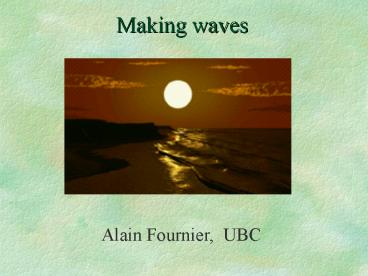Making waves PowerPoint PPT Presentation
Title: Making waves
1
Making waves
Alain Fournier, UBC
2
Making Waves What is the goal
- Computable model
- Geometry in familiar form
- Realistic shape
- Realistic motion
- Depth effect, refraction, wind effects
- Foam, spray
- Level of details, control of complexity
3
What the model is not
- Stochastic
- A fractal
- A height field
- Net transport of water
- A physical model
4
Previous and following work
- Nelson Max Carlas Island (81)
- Ken Perlins noise (85)
- Darwin Peacheys waves (86)
- Tso and Barsky (85)
- Musgrave, Foster, Metaxas, and many dynamic
models.
5
The basic model
- Lagrangian a grid is created and each grid point
moves, but relationship is kept - Each point moves in a circular orbital
- x x0 r sin(k x0 - w t )
- z z0 - r cos(k x0 - w t )
6
Parametric equation
- For t 0 and z0 0
- x -a / k - r sin (a)
- z - r cos(a)
- where a - k x0
7
Wave characteristics
- Height H 2r
- Wavelength L 2 p / k
- Period T 2 p / w
- Phase speed c L/T w / k (eg speed at which
crest travels)
8
Shape parameter
- Steepness of the wave H/L is the shape parameter
- H/L k r / p
9
Some relationships
- L g T2 / 2 p (in deep water)
- c g T / 2 p (in deep water)
- Group velocity U c/2 (speed at which energy
carried travels) - If average wind speed is V, under some
conditions - H 7.065 10-3 V 2.5
10
Special effects
- Go to 2D (wave direction)
- Put wind effect (speed up orbital at top, slow
down at bottom) l - Depth effect at depth h k tanh(k h ) k0
- k0 is k at infinite depth
- can be approximated by
- k k0 / sqrt( tanh (k0 h))
11
Effects of effects
- l (wind effect) affects shape
- k (depth effect) affects wavelength, therefore
phase speed, so causes refraction - depth effect has to be cumulative over depth
history of wave
12
Breakers, spray and foam
- Particle speed greater than phase speed
- Curvature has to be high
- In model, particle (foam) is generated is
curvature above threshold, leaves the wave
(spray) if speed is above threshold. - Direction and speed of spray is known
13
Trains
- Wave train is group of waves with same
characteristics - Implemented as rectangular boxes with same
height, period, wavelength, direction and its own
speed. - For fun also has height envelope and holes to
introduce more variations
14
Trains (continued)
- Trains actually have their own grid (usually
rather low resolution, eg 5x5 or 10x10) to gather
own information (such as depth history) - Time decay effect can be introduced
- Trains can be backed up for initialization
- Train files describe several trains.
15
Typical train file
16
Height data
- Some built-in (slope, platform, funnels)
- Some imported (will be adjusted to size of wave
grid)
17
Rendering
- Youre on your own
- Still to get nice foam and spray
- Speed? Nor worse than basic terrain object
18
Conclusions
- Well, youve got waves
- Its pretty simple
- Its quite flexible
- It can look good
- Its fairly adaptable (OK, very adaptable).

